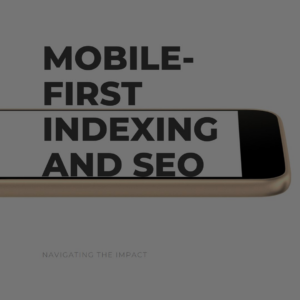Introduction:
With the rise of mobile usage surpassing desktop, Google introduced mobile-first indexing, shifting its focus to prioritize the mobile version of websites for search engine rankings. This seismic change has significant implications for SEO strategies, requiring businesses to adapt to ensure visibility and relevance in the mobile-centric landscape. In this guide, we’ll explore the impact of mobile-first indexing on SEO and strategies to thrive in this mobile-first era.

1. Understanding Mobile-First Indexing:
Mobile-first indexing means that Google predominantly uses the mobile version of a website for indexing and ranking in search results. This shift acknowledges the dominance of mobile devices in internet usage and ensures that Google’s index reflects the mobile user experience accurately. Websites that offer a seamless, mobile-friendly experience are more likely to rank higher in search results, while those with poor mobile optimization may see a decline in visibility.
2. Importance of Mobile Optimization:
Mobile optimization is no longer a nice-to-have but a necessity for SEO success. Websites that are mobile-friendly, responsive, and fast-loading are favored by both users and search engines. Mobile optimization encompasses factors such as responsive design, page speed, usability, and mobile-friendly content formatting. Businesses must prioritize mobile optimization to ensure their websites perform well in mobile search results and provide a positive user experience across devices.
3. Responsive Design and User Experience:
Responsive design is essential for ensuring that websites adapt seamlessly to different screen sizes and devices. A responsive website provides a consistent user experience across desktop, mobile, and tablet devices, eliminating the need for separate mobile and desktop versions. By prioritizing responsive design, businesses can enhance usability, reduce bounce rates, and improve engagement metrics, all of which contribute to higher search engine rankings.
4. Mobile Page Speed and Performance:
Page speed is a critical ranking factor for mobile search, as users expect fast-loading websites on their mobile devices. Businesses should optimize their mobile websites for speed by minimizing server response times, optimizing images and files, leveraging browser caching, and reducing unnecessary scripts and redirects. Improving mobile page speed not only boosts SEO but also enhances user satisfaction and conversion rates.
5. Mobile-Friendly Content:
Content plays a pivotal role in mobile-first indexing, as Google prioritizes mobile-friendly content formats that are easy to read and navigate on small screens. Businesses should create concise, scannable content that is optimized for mobile consumption, including shorter paragraphs, bullet points, and clear headings. Avoid intrusive interstitials and pop-ups that disrupt the user experience on mobile devices and may negatively impact search rankings.
6. Structured Data and Schema Markup:
Structured data and schema markup provide additional context to search engines about the content of a webpage, improving its visibility and relevance in search results. Businesses should implement structured data markup for mobile websites to enhance rich snippets, featured snippets, and other search result enhancements that improve click-through rates and user engagement. Structured data helps search engines understand and interpret mobile content more effectively, leading to better rankings and visibility.
7. Mobile-Friendly Navigation and Design Elements:
Navigation and design elements play a crucial role in mobile user experience and SEO performance. Businesses should prioritize intuitive navigation, clear calls-to-action, and easy-to-find information on their mobile websites. Optimize menus, buttons, and links for touch-screen interaction and ensure that important content is easily accessible without excessive scrolling or pinching. A seamless mobile navigation experience enhances user engagement and satisfaction, leading to improved SEO outcomes.
8. Continuous Monitoring and Optimization:
SEO is an ongoing process, and mobile-first indexing requires continuous monitoring and optimization to maintain visibility and relevance in search results. Businesses should regularly audit their mobile websites for mobile-friendliness, page speed, usability, and other SEO factors. Monitor search performance metrics, user behavior, and algorithm updates to identify areas for improvement and adapt your SEO strategy accordingly.
Conclusion:
Mobile-first indexing represents a fundamental shift in how Google ranks and prioritizes websites in search results, placing mobile optimization at the forefront of SEO strategies. By prioritizing mobile optimization, responsive design, page speed, user experience, mobile-friendly content, structured data, and continuous monitoring and optimization, businesses can adapt to the mobile-first era and thrive in an increasingly mobile-centric digital landscape.



